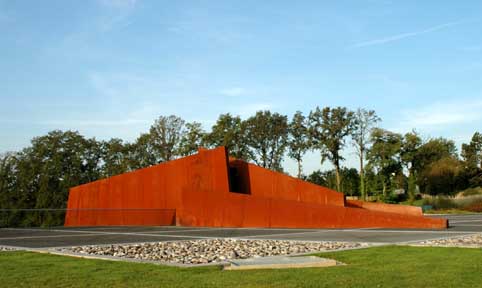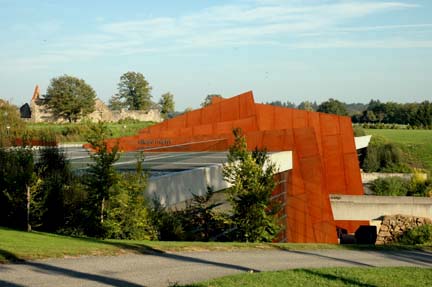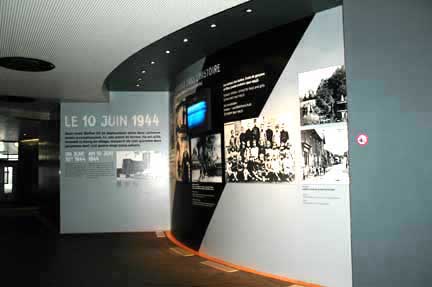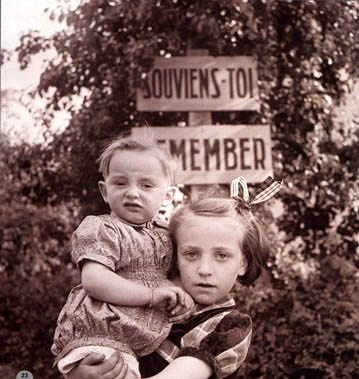The Oradour-sur-Glane Center
of Memory

The photo above shows the Center of Memory,
which is a Museum and tourist center for the ruined village of
Oradour-sur-Glane. The building is actually underground, but
it is built on a hillside so that there are windows at ground
level on the other side of the building.
In the photo below, notice the buildings
in the background on the left side; this is part of the ruined
village, which is directly across the road from the Center of
Memory.

The only entrance to the ruined village
of Oradour-sur-Glane today is through the Center of Memory at
the edge of the new town. The door to the Center opens at 9 a.m.
and visitors must walk down a set of outside stairs, go through
the lobby of the Center and into a tunnel that goes under the
road to a flight of stairs on the other side. At the top of the
stairs is the entry gate into the ruins. Elevators, or lifts,
are available for the handicapped.
When I first walked into the Center of
Memory, I was taken aback by the enormous panoramic photo in
the lobby. It shows Hitler, facing a huge crowd of people, while
he is making a speech in Munich in 1936. I think a photo of Charles
de Gaulle would be more appropriate. However, the photo reflects
the theme of the Center of Memory, which is that Hitler and the
Nazis were to blame for the tragedy of Oradour-sur-Glane. But
instead of showing the evilness of Hitler, this photo depicts
his overwhelming popularity among the German people. Some of
the French people collaborated with the Nazis after the fall
of France in 1940, while others fought as insurgents under the
leadership of Charles de Gaulle.
On the way through the Center to the
tunnel that leads to the entrance of the ruins, there are photos
of German soldiers burning a village in Belarus on the eastern
front in 1941. The caption tells us that this was where the Nazis
first began burning innocent villages. The photo below shows
the display near the entrance to the tunnel, which is on the
extreme left.

The old photo below, which shows two
French children standing in front of the sign at the entrance
to the ruins, is included in the display shown above. The caption
says that the German SS soldiers dishonored their mothers by
killing children, but the caption doesn't mention the French
soldiers from Alsace who took part in the massacre and also killed
children, some of whom were refugees from Alsace.

Entrance to the ruins is free, but there
is a charge for the exhibits. The two photos below were scanned
from a book entitled "Centre of Remembrance for Oradour,
Permanent Exhibition," which I purchased from the book store
in the Center of Memory. The exhibit begins with the story of
the Nazis and then continues on with the history of Oradour-sur-Glane.
The top photo below shows Area 1 of the
exhibits, which is about the rise of Nazism in Germany. The bottom
photo shows Area 2 which is about the Terror in the East, Terror
in the Limousin and Preparing to "make an example"
out of Oradour-sur-Glane. Understandably, the exhibits are presented
only from the French point of view. From the German point of
view, the civilian partisans were the "terrorists"
who were fighting illegally in violation of the rules of the
Geneva Convention of 1929.

Area 3 is an account of the massacre
in Oradour; area 4 is about the discovery of the ruins and "Justice
and amnesty." Area 5 is devoted to "A desire for peace."
The following quote from the book about
the exhibits explains why the innocent village of Oradour-sur-Glane
was chosen to be made into an example:
On 9 June the Waffen-SS 'Der Führer,'
one of two amoured infantry units in the 'Das Reich' regiment
took over Limoges and its surrounds. The general staff of the
four companies commandeered accommodation in Limoges while the
1st battalion with staff and four companies settled themselves
to the west in Rochechouart and Saint-Junien.
From archival material we know about
meetings that were held. On Friday 9 June, the Milice met in
Limoges. On the morning of Saturday 10 June first in Limoges,
then in Saint-Junien, Waffen SS officers and SS police posted
to Limoges met. The Milice would follow their operations. Several
days earlier, on 5 June, a memo from the SS General commanding
the division mentioned "making an example" and this
was confirmed in another memo sent this same Saturday 10 June
saying it would be put into action.
Troops were billeted in the evening
of 10 June in Nieul. Oradour lies between Saint-Junien and Nieul.
|